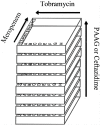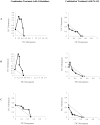Novel glycopolymer sensitizes Burkholderia cepacia complex isolates from cystic fibrosis patients to tobramycin and meropenem
- PMID: 28662114
- PMCID: PMC5491046
- DOI: 10.1371/journal.pone.0179776
Novel glycopolymer sensitizes Burkholderia cepacia complex isolates from cystic fibrosis patients to tobramycin and meropenem
Abstract
Burkholderia cepacia complex (Bcc) infection, associated with cystic fibrosis (CF) is intrinsically multidrug resistant to antibiotic treatment making eradication from the CF lung virtually impossible. Infection with Bcc leads to a rapid decline in lung function and is often a contraindication for lung transplant, significantly influencing morbidity and mortality associated with CF disease. Standard treatment frequently involves antibiotic combination therapy. However, no formal strategy has been adopted in clinical practice to guide successful eradication. A new class of direct-acting, large molecule polycationic glycopolymers, derivatives of a natural polysaccharide poly-N-acetyl-glucosamine (PAAG), are in development as an alternative to traditional antibiotic strategies. During treatment, PAAG rapidly targets the anionic structural composition of bacterial outer membranes. PAAG was observed to permeabilize bacterial membranes upon contact to facilitate potentiation of antibiotic activity. Three-dimensional checkerboard synergy analyses were used to test the susceptibility of eight Bcc strains (seven CF clinical isolates) to antibiotic combinations with PAAG or ceftazidime. Potentiation of tobramycin and meropenem activity was observed in combination with 8-128 μg/mL PAAG. Treatment with PAAG reduced the minimum inhibitory concentration (MIC) of tobramycin and meropenem below their clinical sensitivity breakpoints (≤4 μg/mL), demonstrating the ability of PAAG to sensitize antibiotic resistant Bcc clinical isolates. Fractional inhibitory concentration (FIC) calculations showed PAAG was able to significantly potentiate antibacterial synergy with these antibiotics toward all Bcc species tested. These preliminary studies suggest PAAG facilitates a broad synergistic activity that may result in more positive therapeutic outcomes and supports further development of safe, polycationic glycopolymers for inhaled combination antibiotic therapy, particularly for CF-associated Bcc infections.
Conflict of interest statement
Figures


Similar articles
-
In Vitro Activity of a Novel Glycopolymer against Biofilms of Burkholderia cepacia Complex Cystic Fibrosis Clinical Isolates.Antimicrob Agents Chemother. 2019 May 24;63(6):e00498-19. doi: 10.1128/AAC.00498-19. Print 2019 Jun. Antimicrob Agents Chemother. 2019. PMID: 30910901 Free PMC article.
-
Two case reports of the successful eradication of new isolates of Burkholderia cepacia complex in children with cystic fibrosis.BMC Pharmacol Toxicol. 2016 Mar 28;17:14. doi: 10.1186/s40360-016-0054-0. BMC Pharmacol Toxicol. 2016. PMID: 27018049 Free PMC article.
-
Activity of Cysteamine against the Cystic Fibrosis Pathogen Burkholderia cepacia Complex.Antimicrob Agents Chemother. 2016 Sep 23;60(10):6200-6. doi: 10.1128/AAC.01198-16. Print 2016 Oct. Antimicrob Agents Chemother. 2016. PMID: 27503654 Free PMC article.
-
Antibiotic treatment of multidrug-resistant organisms in cystic fibrosis.Am J Respir Med. 2003;2(4):321-32. doi: 10.1007/BF03256660. Am J Respir Med. 2003. PMID: 14719998 Review.
-
Burkholderia cepacia complex infections: More complex than the bacterium name suggest.J Infect. 2018 Sep;77(3):166-170. doi: 10.1016/j.jinf.2018.07.006. Epub 2018 Jul 24. J Infect. 2018. PMID: 30012345 Review.
Cited by
-
Burkholderia multivorans Exhibits Antibiotic Collateral Sensitivity.Microb Drug Resist. 2020 Jan;26(1):1-8. doi: 10.1089/mdr.2019.0202. Epub 2019 Aug 8. Microb Drug Resist. 2020. PMID: 31393205 Free PMC article.
-
In Vitro Activity of a Novel Glycopolymer against Biofilms of Burkholderia cepacia Complex Cystic Fibrosis Clinical Isolates.Antimicrob Agents Chemother. 2019 May 24;63(6):e00498-19. doi: 10.1128/AAC.00498-19. Print 2019 Jun. Antimicrob Agents Chemother. 2019. PMID: 30910901 Free PMC article.
-
Novel Glycopolymer Eradicates Antibiotic- and CCCP-Induced Persister Cells in Pseudomonas aeruginosa.Front Microbiol. 2018 Aug 3;9:1724. doi: 10.3389/fmicb.2018.01724. eCollection 2018. Front Microbiol. 2018. PMID: 30123191 Free PMC article.
-
Rare or Unusual Non-Fermenting Gram-Negative Bacteria: Therapeutic Approach and Antibiotic Treatment Options.Antibiotics (Basel). 2025 Mar 16;14(3):306. doi: 10.3390/antibiotics14030306. Antibiotics (Basel). 2025. PMID: 40149115 Free PMC article. Review.
-
Burkholderia cenocepacia Infections in Cystic Fibrosis Patients: Drug Resistance and Therapeutic Approaches.Front Microbiol. 2017 Aug 22;8:1592. doi: 10.3389/fmicb.2017.01592. eCollection 2017. Front Microbiol. 2017. PMID: 28878751 Free PMC article. Review.
References
-
- McDowell A, Mahenthiralingam E, Dunbar KE, Moore JE, Crowe M, Elborn JS. Epidemiology of Burkholderia cepacia complex species recovered from cystic fibrosis patients: issues related to patient segregation. J Med Micro. 2004; 53(7):663–8. - PubMed
-
- Lyczak JB, Cannon CL, Pier GB. Lung infections associated with cystic fibrosis. Clin Microbiol Rev. 2002; 15:194–222. doi: 10.1128/CMR.15.2.194-222.2002 - DOI - PMC - PubMed
-
- Carla PC, Sandra CS, Andreia M, Nuno PM, Ana SM, Isabel S. Long-term colonisation of cystic fibrosis lung by Burkholderia cepacia complex bacteria. Front Cell Infect Microbiol. 2011; 1:12 doi: 10.3389/fcimb.2011.00012 - DOI - PMC - PubMed
-
- McCloskey M, McCaughan J, Redmond AOB, Elborn JS. Clinical outcome after acquisition of Burkholderia cepacia in patients with cystic fibrosis. Irish J Med Sci. 2001; 170:28–31. - PubMed
-
- Burns JL, Van DJM, Shawar RM, Otto KL, Garber RL, Quan RM et al. Effect of chronic intermittent administration of inhaled tobramycin on respiratory microbial flora in patients with cystic fibrosis. J Infect Dis. 1999; 179:1190–1196. doi: 10.1086/314727 - DOI - PubMed
MeSH terms
Substances
LinkOut - more resources
Full Text Sources
Other Literature Sources
Medical
Molecular Biology Databases

